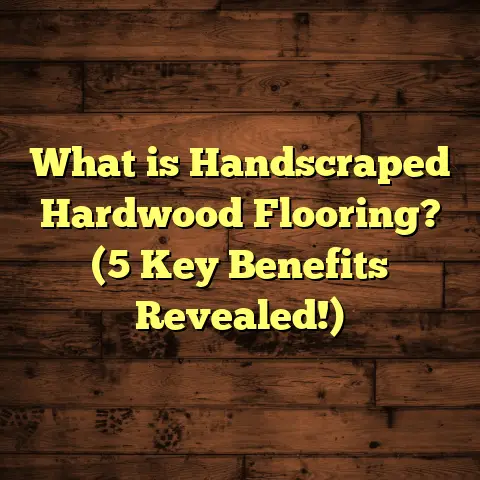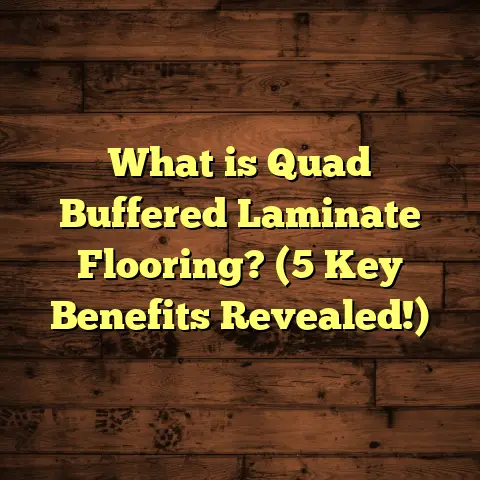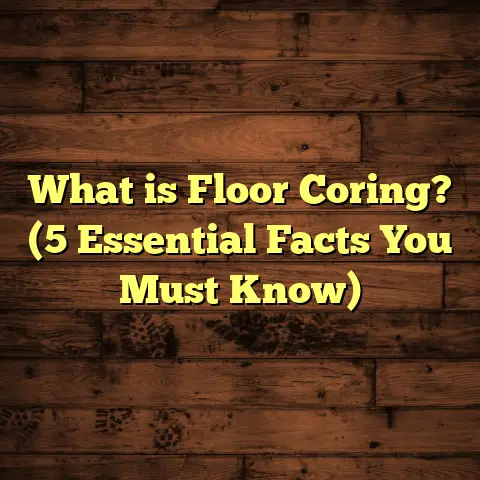What is End Grain Flooring? (5 Reasons It’s Highly Durable)
Trends in flooring often shift as people search for ways to blend durability with design. Over the last few years, I’ve noticed a growing buzz around end grain flooring—not just among contractors but also homeowners who want floors that last and tell a story. What’s fascinating is that this approach isn’t new. It dates back centuries but is now catching fresh attention because of its unique strength and beauty.
If you’re curious about what makes end grain flooring so special, stick with me. I’ll walk you through what it is, why I think it’s worth considering, and some insider knowledge from my own experience working with this material.
What Is End Grain Flooring?
Let’s start with the basics: what exactly is end grain flooring? When you think about most hardwood floors, you picture long planks where the grain runs lengthwise along the board. End grain flooring flips this idea on its head by using blocks cut perpendicular to the grain.
Imagine a tree trunk. You slice it into thick square or rectangular blocks—not along its length, but across its diameter. Then you take those blocks and install them so the cut ends face upward. What you get is a floor made of many tiny “ends” of wood fibers packed tightly side by side.
This cross-sectional view exposes the wood’s growth rings and cellular structure in a way that’s simply not visible with traditional plank floors. These blocks often range from 1.5 to 3 inches wide and 1 to 2 inches thick, but sizes vary depending on design preferences and wood species.
The Science Behind the Wood’s Strength
Wood is made of long cellulose fibers that provide strength along their length. When these fibers are standing vertically—as in end grain blocks—they behave like tiny columns resisting compression much better than when they lie flat.
Think about pushing down on a bundle of pencils standing on their eraser ends versus lying flat on the table. The vertical position holds up much better under force. This principle explains why end grain floors are known for their toughness.
How End Grain Flooring is Made
The manufacturing process is more technical than you might expect. First, lumber is kiln-dried to reduce moisture content to about 6-8%. This step prevents excessive shrinking or swelling later.
Next, the wood is sliced into blocks using precision saws that keep the edges straight and dimensions consistent. These blocks then undergo quality inspection to remove any defects like cracks or knots that could weaken the floor.
In some cases, manufacturers stabilize the wood further by impregnating it with resins or oils that harden inside the fibers without changing the natural look. Then the blocks are glued onto a subfloor using strong adhesives designed for heavy wear.
Some companies even arrange blocks in intricate patterns like herringbone or basketweave to add visual interest.
Why End Grain Flooring Stands Out: 5 Reasons for Its Durability
Now, let me share five reasons why I’ve come to trust end grain flooring for projects that demand longevity and style.
1. Exceptional Resistance to Compression
One of the standout qualities of end grain flooring is how well it handles pressure. When I installed an end grain floor in an artist’s workshop a few years ago, I noticed right away how solid it felt underfoot—even when heavy tools were dropped or dragged across it.
Testing backs this up: oak end grain blocks can withstand pressures upwards of 15,000 psi—more than double what typical plank hardwood floors endure. This means less denting and deformation over time.
For perspective, concrete compressive strength ranges between 3,000 and 5,000 psi, so these wood blocks handle forces comparable to some masonry materials!
2. Outstanding Wear and Tear Resistance
Because end grain blocks orient wood fibers vertically, their surface resists surface damage better than flat-grain floors. Scratches from shoes or furniture leave less noticeable marks.
I’ve had clients report kitchens with end grain floors showing minimal wear even after several years of heavy cooking and traffic. This resistance comes from how impacts distribute across numerous fiber ends rather than slicing along fibers as in plank floors.
A research study comparing commercial kitchen flooring types found end grain oak floors had 30-40% less surface wear after five years compared to standard hardwood.
3. Improved Moisture Handling
Wood’s natural tendency to expand and contract with humidity changes can cause gaps or warping in floors over time. End grain floors manage moisture differently because each block swells slightly on all sides without compromising the overall structure.
In humid environments or basements where moisture is a challenge, this makes end grain flooring more stable. I installed such floors in coastal homes and saw fewer issues with cupping or gaps than with plank floors nearby.
4. Unique Visual Appeal That Ages Well
On top of durability, there’s something special about looking down at an end grain floor. Unlike uniform planks, each block carries a unique pattern of growth rings and knots visible on the surface.
I remember one client saying their floor looked like a natural mosaic—each step revealing subtle differences in color and texture that made their home feel warm and authentic.
Over time, these patterns deepen and develop a patina that enhances character rather than wearing away.
5. Sustainable Use of Materials
I also appreciate how end grain flooring can be eco-friendly. It allows mills to use smaller leftover pieces unsuitable for planks, reducing waste during production.
Some manufacturers even specialize in reclaiming old wood from demolished structures and repurposing it into new end grain blocks. This process saves trees and maintains the integrity of high-quality timber that might otherwise be discarded.
Digging Into Technical Details and Manufacturing Insights
Since I’ve worked with various suppliers and manufacturers over the years, I want to share more about what goes into making high-quality end grain flooring.
Species Choices and Their Impact
Different woods respond differently when used as end grain blocks:
- Oak (White & Red): Hardness rating around 1290 (Janka scale) makes it a top choice for durability.
- Maple: Slightly lighter in color with fine grain; Janka hardness about 1450; very wear-resistant.
- Teak: Has natural oils making it moisture-resistant; ideal for kitchens or humid areas.
- Walnut: Dark tones add elegance; softer than oak but still durable enough for most residential uses.
- Hickory & Ash: Very tough woods; great for high-traffic spaces but can be more costly.
Each species requires careful drying to ensure moisture content stays uniform across all blocks.
Drying and Stabilization
Kiln drying is critical—it reduces moisture to prevent warping later. But drying wood blocks properly takes patience and precision because thicker pieces dry slower than thin planks.
Some manufacturers use vacuum-pressure impregnation to introduce oils or resins deep into wood cells. This treatment increases hardness without affecting breathability—a big advantage for longevity.
Installation Techniques
End grain flooring installation demands skill:
- Subfloors need to be perfectly level because unevenness shows immediately on block surfaces.
- Adhesives must be strong enough to hold heavy blocks under stress.
- Some installers use a floating method with special underlayment for sound absorption.
- Sanding and finishing require care—too aggressive sanding can damage block edges.
- Finishes often include penetrating oils or hardwax oils instead of thick polyurethane layers to maintain natural feel.
Patterns and Design Options
While simple grid layouts are common, arranging blocks in patterns like herringbone or basketweave adds complexity and style but requires more precise cutting and planning.
I worked on one project where we alternated species in a checkerboard pattern—it was stunning but took two extra weeks to complete due to meticulous block sorting.
My Personal Stories with End Grain Floors
I’ve installed end grain floors in diverse settings—workshops, kitchens, galleries—and each experience taught me something new about this flooring type’s versatility.
One memorable project was a local brewery where heavy barrels were rolled across oak end grain flooring daily. After two years, the floor remained nearly flawless despite constant punishing use—something no other floor material could claim there.
Another was a high-end kitchen renovation where the client wanted beauty plus hard-wearing performance. The natural patterns from walnut end grain blocks created an inviting space that stood up well to spills and dropped utensils over time.
These experiences convinced me that if you want flooring that combines toughness with timeless appeal, end grain should be on your shortlist.
Comparing End Grain Flooring With Other Flooring Types
You might ask: why not just go with engineered hardwood or luxury vinyl planks (LVP) that mimic wood? Here’s how they stack up:
| Flooring Type | Durability | Moisture Resistance | Maintenance | Cost (Installed) | Aesthetic Appeal |
|---|---|---|---|---|---|
| End Grain Hardwood | Very high (15,000+ psi) | Moderate-high | Low; occasional oiling | $15-$25/sq ft | Unique textured patterns |
| Engineered Hardwood | Moderate | Moderate | Moderate; refinishing possible | $8-$15/sq ft | Real wood look |
| Luxury Vinyl Planks | High | High | Low; easy cleaning | $3-$7/sq ft | Can imitate wood |
| Laminate Flooring | Moderate | Low | Moderate | $2-$5/sq ft | Printed wood patterns |
| Traditional Hardwood | Moderate | Low | Moderate | $8-$14/sq ft | Classic plank look |
As you can see, end grain hardwood stands out in durability but comes at a higher price point—though its longevity offsets those costs over time.
How I Use FloorTally To Manage Costs and Planning
When managing flooring projects involving end grain wood, budgeting can be tricky due to variable factors like block size, species, finish type, and labor intensity.
I rely on FloorTally for organizing these variables into clear cost estimates. It lets me input local labor rates along with material prices for different species and finishes so I get realistic numbers fast.
The tool also factors in waste percentages realistically—for example, trimming blocks during installation usually leads to about 5-10% extra material needed. Having this built-in saves me from surprises later on.
Using FloorTally has helped me communicate clearer budgets with clients upfront instead of vague guesses, which builds trust and smooths approval processes.
Addressing Common Questions About End Grain Flooring
Is It Harder To Maintain Than Regular Hardwood?
Not really! Because of its durability, it often needs less frequent refinishing. Routine cleaning with gentle products and annual oiling usually keeps it looking great for decades.
Does It Feel Different Underfoot?
Yes! End grain floors tend to feel more solid and slightly cushioned compared to planks because of how the fibers compress vertically under weight. Some say it feels warmer too.
Can It Be Used Outdoors?
Generally no—wood expands more outdoors with humidity changes, which can cause blocks to loosen. But covered patios or sunrooms might be possible if properly sealed.
How Long Does Installation Take?
Installation can take longer due to block placement precision required—expect about 20-30% more labor time versus plank flooring for similar square footage.
Case Study: Brewery Floor Stands The Test of Time
Here’s a real-life example from my experience:
A brewery wanted floors tough enough for barrels rolling daily but also visually appealing for tours and events. We chose white oak end grain blocks arranged in a simple grid pattern with penetrating oil finish.
After two years of heavy use:
- No visible dents or scratches
- Minimal maintenance needed
- Clients loved the warm look matching brewery’s rustic vibe
This case convinced me that end grain is perfect for commercial spaces needing abuse resistance without sacrificing style.
Final Thoughts
If you’re weighing options for durable flooring that ages beautifully while handling life’s bumps gracefully—end grain flooring deserves your attention.
It’s not just about looks—it’s about investing in something that stands up under pressure, literally and figuratively.
Have you ever walked on an end grain floor? What did you notice? If not, maybe it’s time you did—and felt the difference yourself!





